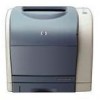HP 2500 HP Jetdirect Print Servers - Administrator Guide - Page 136
Configuring for LPD, Printing, Then
 |
View all HP 2500 manuals
Add to My Manuals
Save this manual to your list of manuals |
Page 136 highlights
Table 4.9 Item LPD Queue Parameters (3 of 3) Description Value The content of the string. The String Name parameter names the string; the Value parameter defines its content. When a string name is specified for a prepend or append string (in the table at the top of the browser window), the line printer daemon sends the value of that string to the printer before or after the print data (as appropriate). Character values can be anywhere in the extended ASCII range of 0 to 255 (hex 00 to FF). You can specify a non-printing character using its hexadecimal value, by entering a backslash followed by two hexadecimal characters. For example, to enter the escape character (hex 1B), type in \1B. If your string includes the backslash character itself, specify it as \5C. The maximum number of characters you can type into this field is 240. The characters in the field are checked for hexadecimal values, converted if necessary, and stored internally. The maximum number of characters stored internally in the string is 80; any characters that exceed this are discarded. To set up a user-defined print queue, you first define the strings, assign them as prepend or append strings, and define the queue type. Once you have defined an LPD queue, you specify its use by setting up an LPD printer that uses that queue. For instance, if you set up string "a" with a value of "abc" and string "z" with a value of "xyz", you can define print queue "az_queue" with a prepend string of "a", an append string of "z", and a queue type of "raw". Then, when you send a print job consisting of through queue az_queue, the job sent to the printer is "abcxyz". Instructions for setting up an LPD printer are different for different operating systems; refer to Chapter 5, "Configuring for LPD Printing" for details. ENWW Using the Embedded Web Server 136















